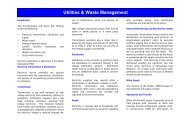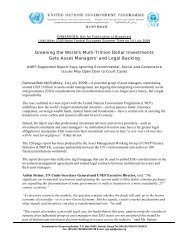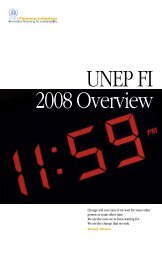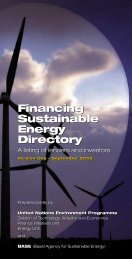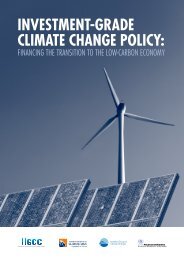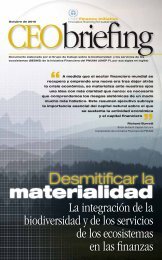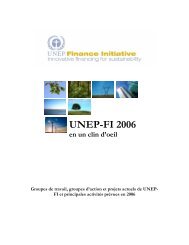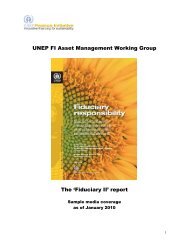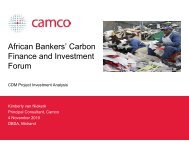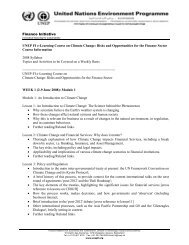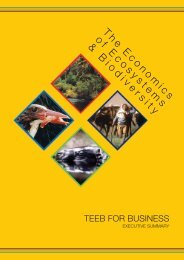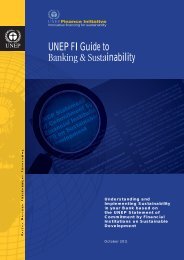Natural Resources and Civil War - UNEP Finance Initiative
Natural Resources and Civil War - UNEP Finance Initiative
Natural Resources and Civil War - UNEP Finance Initiative
You also want an ePaper? Increase the reach of your titles
YUMPU automatically turns print PDFs into web optimized ePapers that Google loves.
<strong>Natural</strong> <strong>Resources</strong> <strong>and</strong> <strong>Civil</strong> <strong>War</strong>: An Overview<br />
Prof. Michael Ross<br />
UCLA Department of Political Science<br />
mlross@polisci.ucla.edu<br />
August 15, 2003<br />
Submitted for review to World Bank Research Observer. An earlier version of this paper<br />
was presented at the conference on “The Governance of <strong>Natural</strong> <strong>Resources</strong> Revenues,”<br />
sponsored by the World Bank <strong>and</strong> the Agence Francaise de Developpement, Paris,<br />
December 9-10, 2002. The views in this paper are the author’s alone, <strong>and</strong> may not reflect<br />
the views of the World Bank or the AFD. The author thanks Paul Collier, Havard Hegre,<br />
<strong>and</strong> the WBRO editors for helpful comments on earlier drafts.
Abstract<br />
Since the mid-1990s there has been a growing body of research on the causes of civil<br />
wars. One of the most surprising <strong>and</strong> important findings is that natural resources – in<br />
particular, oil <strong>and</strong> gemstones – play a key role in triggering <strong>and</strong> prolonging these<br />
conflicts.<br />
This paper summarizes recent findings on natural resources <strong>and</strong> civil war. It<br />
explains four ways that resources increase the hazard of civil war: by harming a country’s<br />
economic performance; by making its government weaker, more corrupt, <strong>and</strong> less<br />
accountable; by giving people who live in resource-rich regions an incentive to form an<br />
independent state; <strong>and</strong> by helping finance rebel movements. These patterns help explain<br />
the unusually high rate of civil wars in Sub-Saharan Africa, a region with many resourcedependent<br />
states.<br />
2
Introduction<br />
Since the mid-1990s there has been a growing body of research on the causes of civil<br />
wars. One of the most surprising <strong>and</strong> important findings is that natural resources play a<br />
key role in triggering, prolonging, <strong>and</strong> financing these conflicts.<br />
The “natural resources” that cause these problems are largely oil <strong>and</strong> hard-rock<br />
minerals – including oil, gold, coltan, diamonds, <strong>and</strong> other gemstones. Sometimes other<br />
types of resources – notably timber – also play a role. And if drugs are considered a<br />
natural resource, they too have played an important role in several conflicts. Table One<br />
lists seventeen recent conflicts that are linked to natural resources. In eight of these<br />
conflicts, gemstones are one of the resources; in six conflicts, the resource is oil or<br />
natural gas; in five, it is some type of illicit drug; <strong>and</strong> in three cases, it is timber. In most<br />
of the conflicts, multiple resources play a role.<br />
Over half of the conflicts in Table One are in Africa. Since many African states<br />
are highly-dependent on oil, gas, <strong>and</strong> mineral exports, they are unusually prone to<br />
resource-related conflict. Conversely, the region’s mineral abundance helps explain why<br />
a growing share of the world’s civil wars taken place in Africa. 1<br />
In most regions of the<br />
world, the end of the Cold <strong>War</strong> led to a sharp drop in the number of civil wars, as the<br />
U.S., Soviet Union, <strong>and</strong> France reduced their financial support for peripheral<br />
insurgencies. Between 1992 <strong>and</strong> 2001, the number of armed conflicts outside of Africa<br />
dropped by half; yet in Africa the number of conflicts has stayed roughly the same<br />
[Figure Two]. Moreover, within Africa, armed conflicts have grown more severe.<br />
During the 1970’s <strong>and</strong> 1980’s, half of all intrastate conflicts in Africa could be classified<br />
1 Another important reason for this trend is the persistance of poverty in Africa;<br />
poverty significantly raises the risk of civil war.<br />
3
as civil wars – that is, they generated at least one thous<strong>and</strong> battle-related deaths each<br />
year. In the 1990’s, two-thirds of Africa’s intrastate conflicts were civil wars. Africa had<br />
seven civil wars in the 1970’s, eight in the 1980’s, <strong>and</strong> fourteen in the 1990’s [Figure<br />
Two].<br />
Before proceeding, it is important to emphasize two points. First, natural<br />
resources are never the only source of a conflict. Any given conflict is brought about by<br />
a complex set of events; often poverty, ethnic or religious grievances, <strong>and</strong> unstable<br />
governments also play major roles. But even after these factors have been taken into<br />
account, studies consistently find that natural resources heighten the danger that a civil<br />
war will break out, <strong>and</strong> once it breaks out, that conflict will be more difficult to resolve.<br />
Second, natural resource dependence never makes conflict inevitable. Resource<br />
wealth raises the danger of civil war, but for every resource-rich country that has suffered<br />
from violent conflict, two or three have avoided it. <strong>Civil</strong> wars are still rare events.<br />
Outside of Africa, they are also getting rarer.<br />
This article gives an overview of what recent scholarship can tell us about the role<br />
that natural resources play in civil wars. It describes four main pathways by which<br />
resources lead to armed conflict: through their effects on economies; through their effects<br />
on governments; through their effects on people living in resource-rich regions; <strong>and</strong><br />
through their effects on rebel movements. 2<br />
2 Important studies that touch on the role of natural resources in civil wars – <strong>and</strong><br />
which I draw on in this article – include: Keen 1998; Collier <strong>and</strong> Hoeffler 1998, 2001;<br />
Elbadawi <strong>and</strong> Sambanis 2001; Fearon <strong>and</strong> Laitin 2002; Fearon 2002; Hegre 2002;<br />
Reynal-Querol 2002; Doyle <strong>and</strong> Sambanis 2001; De Soysa 2002; Buhaug <strong>and</strong> Gates<br />
2002; <strong>and</strong> Ross 2002a, 2002b.<br />
4
1. Resource Dependence <strong>and</strong> Economic Performance<br />
Resource dependence appears to make countries more susceptible to civil war through<br />
two economic effects: by reducing growth <strong>and</strong> by increasing poverty.<br />
Economic Growth<br />
It may seem paradoxical that a ‘gift’ from nature of abundant oil, gold, or gemstones<br />
tends to cause economic distress. Yet study after study has found that resourcedependent<br />
economies grow more slowly than resource-poor economies. 3<br />
A recent report<br />
by the World Bank, for example, looked at the economic performance in the 1990s of<br />
countries that had large mining sectors. 4<br />
It found that in countries with medium-sized<br />
mining sectors (between 6 <strong>and</strong> 15 percent of all exports), GDP per capita fell at an<br />
average rate of 0.7 percent a year over the course of the decade. In countries with large<br />
mining sectors (between 15 <strong>and</strong> 50 percent of exports), GDP per capita dropped by an<br />
average of 1.1 percent a year, while in countries with very large mining sectors (over 50<br />
percent of exports) GDP per capita dropped by a remarkable 2.3 percent a year.<br />
Collectively these mining states saw their GDP per capita fall at 1.15 percent a year – a<br />
drop over the course of the decade of almost 11 percent. 5<br />
This is a catastrophic record on economic grounds alone. But it also has<br />
implications for susceptibility of these states to civil war: recent studies suggest that<br />
3 There is still much speculation about why this occurs. See Sachs <strong>and</strong> <strong>War</strong>ner<br />
2001; Gylfason 2001; Manzano <strong>and</strong> Rigobon 2001; Leite <strong>and</strong> Weidemann 1999; Sala-i-<br />
Martin <strong>and</strong> Subramanian 2003. Ross 1999 reviews many earlier studies.<br />
4 This study looked only at non-fuel minerals, i.e., not oil or natural gas.<br />
5 World Bank 2002; see also Ross 2002c.<br />
5
when a country’s growth rate turns negative, a civil war is more likely to break out. 6<br />
In<br />
the three years leading up to the war in the Democratic Republic of Congo, for example,<br />
GDP growth averaged –5.56 percent; in the three years before the Congo Republic’s civil<br />
war, growth was -1.94 percent; on the eve of Liberia’s civil war, growth averaged –1.34<br />
percent. 7<br />
Poverty Rates<br />
A country’s reliance on non-fuel mineral exports – <strong>and</strong> possibly oil exports as well – also<br />
tends to create atypically high poverty rates. A key reason is that resource-rich<br />
governments do an unusually poor job of providing education <strong>and</strong> health care for their<br />
citizens. One study found a strong correlation between greater dependence on oil <strong>and</strong><br />
mineral exports <strong>and</strong> higher child mortality rates: for each increase in minerals<br />
dependence of five points, the mortality rate for children under the age of five rose by<br />
12.7 per thous<strong>and</strong>; for each five point increase in oil dependence, the under-five mortality<br />
rate rose by 3.8 per thous<strong>and</strong>. 8<br />
Again, this pattern is intrinsically worrisome, but it also has consequences for a<br />
state’s susceptibility to violent conflict. The greater a country’s poverty, the more likely<br />
it is to face a civil war. 9<br />
Not surprisingly, people are more likely to rise up against their<br />
government when their economic predicament is bad <strong>and</strong> getting worse. Rebel groups<br />
find it easier to recruit new members when there is widespread poverty <strong>and</strong><br />
6 Collier <strong>and</strong> Hoeffler 2001; Hegre 2002.<br />
7 Figures are taken from World Bank 2001.<br />
8 Ross 2001b. Minerals <strong>and</strong> oil dependence was measured as the ratio of exports<br />
to GDP.<br />
9 Collier <strong>and</strong> Hoeffler 2001; Fearon <strong>and</strong> Laitin 2002; Elbadawi <strong>and</strong> Sambanis<br />
2002.<br />
6
unemployment, since it makes the prospect of combat <strong>and</strong> looting seem more attractive<br />
by comparison.<br />
A glance at the world’s most oil dependent states, <strong>and</strong> most mineral dependent<br />
states, illustrates these patterns. Table Two lists the world’s 20 most mineral-dependent<br />
states; eleven of them are classified by the World Bank as “highly-indebted poor<br />
countries” – the most troubled category of states – even though they earn large sums of<br />
foreign exchange from the sale of their resources. Since 1990, five of them have had<br />
civil wars.<br />
Table Three lists the world’s 20 most oil-dependent states. Here, too, the record<br />
is grim. Three of the top six states are classified as “highly-indebted poor countries,” <strong>and</strong><br />
once again, five of the 20 have suffered from civil wars in the 1990s. 10<br />
2. Resource Dependence <strong>and</strong> Governance<br />
<strong>Natural</strong> resource dependence also has an impact on governments. 11<br />
A strong <strong>and</strong><br />
effective government should be able to offset some of the economic <strong>and</strong> social problems<br />
caused by resource dependence. But resource dependence tends to influence<br />
governments themselves, making them more susceptible to conflict. This seems to occur<br />
through three mechanisms: corruption, state weakness, <strong>and</strong> reduced accountability.<br />
10 Resource dependence may also “dutch disease” effects, but it is not evident that<br />
this makes states more susceptible to civil war.<br />
11 Several recent studies suggest that oil <strong>and</strong> mineral dependence hurt economic<br />
growth primarily by damaging the institutions of governance. See Isham et al. 2003;<br />
Sala-i-Martin <strong>and</strong> Subramanian 2003.<br />
7
Corruption<br />
The first mechanism is government corruption. There is strong evidence that when a<br />
government gets more of its revenue from oil, minerals, <strong>and</strong> timber, it is more likely to be<br />
corrupt. 12<br />
Part of this problem is due to the sheer volume of resource revenues:<br />
governments can only absorb, <strong>and</strong> effectively track, limited amounts of money. Resource<br />
wealth often floods governments with more revenue than they can effectively manage.<br />
Resource revenues also tend to be collected by governments in ways that are unusually<br />
difficult for citizens to track – <strong>and</strong> unusually easy for crooked officials to divert; hence<br />
some of it winds up in off-budget accounts or the pockets of government officials, <strong>and</strong> is<br />
never heard of again.<br />
Other problems stem from the volatility of resource revenues. For the last<br />
century, the international prices for primary commodities – including oil <strong>and</strong> minerals –<br />
have been more volatile than the prices for manufactured goods. 13<br />
Since 1970, this<br />
volatility has grown worse. 14<br />
This means that when countries become more dependent on<br />
oil <strong>and</strong> minerals exports, they also become more vulnerable to economic shocks. Case<br />
studies suggest that the sudden ebb <strong>and</strong> flow of revenues tends to overwhelm normal<br />
budgeting procedures, promote corruption, <strong>and</strong> weaken the ability of government<br />
agencies to remain free from political interference. 15<br />
12 Sachs <strong>and</strong> <strong>War</strong>ner (1999) find a strong correlation between resource<br />
dependence <strong>and</strong> a widely-used measure of corruption; studies by Gylfason (2001) <strong>and</strong><br />
Leite <strong>and</strong> Weidmann (1999) produced similar results. Marshall (2001) also reports<br />
evidence of unusually high corruption rates in the minerals sectors of many countries.<br />
13 Grilli <strong>and</strong> Yang 1988.<br />
14 Reinhart <strong>and</strong> Wickham 1994.<br />
15 Gelb (1988) for example, found that the oil booms of the 1970’s were generally<br />
associated with a sharp drop in the efficiency of public investments, which indicates that<br />
corruption levels were rising. Similarly, Collier <strong>and</strong> Gunning (1999) found that<br />
8
Ironically, the nationalization of foreign oil <strong>and</strong> minerals firms in the 1950s,<br />
1960s, <strong>and</strong> 1970s made states more vulnerable to these kinds of revenue shocks. Before<br />
nationalization, foreign corporations typically captured <strong>and</strong> repatriated a large fraction of<br />
any resource rents, including those created by resource shocks. This "drain" of wealth<br />
was much resented by developing-state governments. Yet ironically, the repatriation of<br />
resource windfalls provided these governments with the unintended benefit of insulating<br />
state institutions from the volatility of international commodity markets. By<br />
expropriating foreign corporations -- at a time when resource prices were growing even<br />
more variable -- resource-exporting governments unwittingly exposed themselves to<br />
large market shocks.<br />
In theory, governments should be able to buffer their economies against these<br />
market shocks by setting up stabilization funds, <strong>and</strong> perhaps, savings funds. Yet in<br />
practice, these funds are often poorly managed <strong>and</strong> may wind up doing more harm than<br />
good. 16 There are, unfortunately, many examples of resource-linked corruption. One of<br />
the most egregious cases is Angola. According to an IMF report, almost $1 billion<br />
disappeared from the Angolan government’s accounts in 2001 alone due to corruption.<br />
Fiscal discrepancies over the previous several years represented between 2 <strong>and</strong> 23 percent<br />
of the country’s gross domestic product. Most of these losses were linked to the<br />
country’s dependence on oil. Large fractions of the signing bonuses for oil contracts<br />
commodity booms in developing states, for a wide range of products, were associated<br />
with a subsequent fall in investment efficiency. Ross’s (2001c) study of the Malaysian,<br />
Indonesian, <strong>and</strong> Philippine timber sectors reports that rising timber prices led to<br />
heightened levels of corruption, <strong>and</strong> the dismantling of institutions that had earlier<br />
protected the forest sector from misuse.<br />
16 Ascher 1999; Davis et al. 2001.<br />
9
disappeared, <strong>and</strong> the state oil company, Sonangol, was criticized for managing the<br />
country’s oil receipts through ‘a web of opaque offshore accounts,’ even though Angolan<br />
law requires that the funds be h<strong>and</strong>led by the central bank. 17<br />
Weak Government<br />
<strong>Natural</strong> resource revenues can, ironically, weaken governments – making them less likely<br />
to resolve social conflicts <strong>and</strong> provide public goods, like health care <strong>and</strong> education.<br />
There are two ways this can happen. One way is by retarding the effectiveness of<br />
a state’s bureaucracy. Some scholars have found that when governments are funded<br />
through oil or mineral revenues instead of taxes, they are left with weaker governments.<br />
Much of a government’s “strength” comes from its capacity to extract taxes from the<br />
population – a capacity that often takes decades to develop. A government that fails to<br />
develop this ability may also be unable to establish the type of bureaucracy that can<br />
provide effective public goods, <strong>and</strong> ameliorate social conflicts. The result may be a<br />
heightened danger of civil war. 18<br />
A second route is by weakening the state’s territorial control. If a country has<br />
resources that are highly valuable, <strong>and</strong> can be mined with little training or investment –<br />
such as alluvial gemstones, coltan or tanzalite – it will be difficult for the government to<br />
provide law <strong>and</strong> order in the extractive region. These kinds of mineral deposits attract<br />
large numbers of artisanal miners to what are typically rural, “frontier” regions, where the<br />
government’s influence is weak. L<strong>and</strong> claims in these areas become valuable, yet the<br />
weakness of the government’s authority makes it hard for claimants to enforce or protect<br />
17 Cauvin 2002. Also see Global Witness 2002.<br />
18 Mahdavy 1970; Beblawi 1987; Karl 1997; Fearon <strong>and</strong> Laitin 2003.<br />
10
their property rights through legal measures. As a result, they often resort to extralegal<br />
measures, including violence, to establish claims <strong>and</strong> adjudicate disputes. The utility of<br />
violence creates a dem<strong>and</strong> for organizations – like criminal gangs, warlords, <strong>and</strong> rogue<br />
military units – that for a price will use extralegal means to enforce mineral claims. 19<br />
In<br />
addition, the high value-to-weight ratios of these minerals make them difficult to tax <strong>and</strong><br />
easy to smuggle; these qualities produce high corruption levels inside the government,<br />
<strong>and</strong> large smuggling operations outside of it. The combination of weak, corrupt<br />
government authority, <strong>and</strong> strong criminal organizations can facilitate the rise of rebel<br />
movements. 20<br />
The case of Sierra Leone illustrates how alluvial minerals, scattered over a wide<br />
area, can weaken a government’s territorial control <strong>and</strong> lead to civil war. From the 1930s<br />
to the 1960s, Sierra Leone had a robust, mineral-based economy that produced iron ore,<br />
gold, bauxite, <strong>and</strong> rutile (titanium oxide), in addition to diamonds. 21<br />
Most of these<br />
resources were mined by foreign firms or state-owned companies that provided the<br />
government with large revenues, <strong>and</strong> enormous patronage resources. But in the 1970s<br />
<strong>and</strong> early 1980’s Sierra Leone’s iron ore <strong>and</strong> kimberlite diamonds were worked out. The<br />
mining of alluvial diamonds by informal methods became, by default, the country’s main<br />
source of non-agricultural wealth.<br />
19 This mechanism has been discussed by several scholars. See, for example,<br />
Michelle Garfinkel <strong>and</strong> Stergios Skaperdas (eds.), The political economy of conflict <strong>and</strong><br />
appropriation. New York: Cambridge University Press (1996);<br />
20 See Reno 1995, 1998; Ross 2002b.<br />
21 Sierra Leone had both kimberlite diamonds, which are diamonds located deep<br />
underground <strong>and</strong> can only be extracted with heavy equipment, <strong>and</strong> alluvial diamonds,<br />
which are scattered in the soil of alluvial plains, <strong>and</strong> can be extracted by unskilled<br />
workers with little training or equipment.<br />
11
The Sierra Leone government had long had difficulty exercising its authority over<br />
the diamond fields, which was home to tens of thous<strong>and</strong>s of unlicensed miners, plus a<br />
network of armed gangs, private armies <strong>and</strong> paramilitary forces that sold protection<br />
services to miners <strong>and</strong> traders. 22<br />
Even before civil war broke out in 1991, Sierra Leone’s<br />
growing dependence on alluvial diamonds was causing problems for the government:<br />
instead of generating revenues, the diamond fields were generating extraordinary levels<br />
of corruption. In 1988 official diamond exports were worth $22,000, while illicit<br />
diamond exports were worth perhaps $250 million. 23<br />
As long as the national economy was otherwise in good shape, the government<br />
was able to manage the corruption, warlords, <strong>and</strong> private armies in the diamond fields.<br />
But in the 1980s the country entered an economic crisis, due to the high price of imported<br />
oil, dropping commodity prices, the mining out of kimberlite diamond <strong>and</strong> iron ore<br />
deposits, <strong>and</strong> economically ruinous government policies. From 1975 to 1990,<br />
government revenues dropped from 14.5 percent to just 3.9 percent of GDP. Moreover,<br />
in 1985 the politically artful President, Siaka Stevens h<strong>and</strong>ed power over to his less adept<br />
successor, Joseph Momoh.<br />
Collectively, these changes led to the deterioration of the central government’s<br />
influence over the diamond-rich areas. Hence when a small group of insurgents called<br />
the Revolutionary United Front – totalling just one hundred men – crossed the border<br />
from Liberia in March 1991, the Sierra Leone government was too weak to repel them.<br />
22 In fact, the mining area was the site of social unrest as early as 1955. See Reno (1995)<br />
op. cit.; Paul Richards, Fighting for the Rain Forest: <strong>War</strong>, Youth, <strong>and</strong> <strong>Resources</strong> in Sierra<br />
Leone. Oxford: James Currey (1996).<br />
23 William Reno, <strong>War</strong>lord Politics <strong>and</strong> African States, Lynne Rienner, Boulder<br />
(1998), p. 120.<br />
12
Instead, the country was drawn into a civil war that lasted ten years, caused between<br />
20,000 <strong>and</strong> 50,000 deaths, <strong>and</strong> displaced at least one-third of the population.<br />
Unaccountable Government<br />
The third effect is reduced government accountability. Governments that get their<br />
income from natural resources become less democratic – <strong>and</strong> hence, less accountable –<br />
than countries that rely on other revenue sources, such as taxation.<br />
One reason for this pattern is that when governments have an abundance of<br />
revenues, they use part of their surplus to quell dissent. Sometimes they do this through<br />
tax policies: resource-rich governments commonly use their revenues to reduce or<br />
eliminate taxes on their populations; in the absence of taxes, people are less likely to<br />
dem<strong>and</strong> accountability from their government. 24<br />
Other times they do it through<br />
spending: greater patronage can also dampen latent pressures for democratization. In<br />
some cases governments use their largesse to prevent the formation of independent social<br />
groups that might eventually dem<strong>and</strong> political rights. 25<br />
Of course, all undemocratic rulers<br />
use their fiscal powers to reduce dissent, but governments in resource-rich states tend to<br />
have extra revenues at their disposal.<br />
A second reason is that oil <strong>and</strong> mineral-rich governments spend an unusually<br />
large fraction of their revenues on the military, which also helps them repress dissent. 26<br />
Figure Three illustrates this pattern: it charts the average military spending (as a fraction<br />
of Gross National Income) of the twenty most oil <strong>and</strong> mineral-dependent, <strong>and</strong> the twenty<br />
24 Ross forthcoming.<br />
25 Moore; V<strong>and</strong>ewalle; Bellin.<br />
26 Ross 2003<br />
13
least oil <strong>and</strong> mineral-dependent, states in the developing world between 1989 <strong>and</strong> 1999.<br />
Military spending is consistently between two <strong>and</strong> four times greater in the mineral-rich<br />
states than in the mineral-poor states.<br />
There are other ways that an extractive industry can boost the influence of the<br />
armed forces. Sometime the industry is controlled by the military, which gives the<br />
military more independence from, <strong>and</strong> greater influence over, the civilian government. In<br />
Indonesia, for example, the military has a large stake in many forest concessions, <strong>and</strong><br />
collects fees from oil, gas, <strong>and</strong> mineral companies. Since this money goes to the military<br />
directly, it does not pass through the central government’s normal budgeting procedures,<br />
<strong>and</strong> the legislature has no influence over how it is spent. The result is that the extractive<br />
sector helps make the military less accountable to the civilian government, undermining<br />
Indonesia’s fragile democracy.<br />
Once again, the harm that resource dependence does to democracy is intrinsically<br />
deplorable, but it can also make states more vulnerable to civil war. Several studies have<br />
found a link between a government’s accountability <strong>and</strong> the likelihood that it will suffer<br />
from a civil war. 27<br />
Governments that are less than fully democratic are less able to<br />
resolve the grievances of their citizens, <strong>and</strong> hence may be more prone to outbreaks of<br />
violent conflict.<br />
It is easy to see how the effects of resource dependence on economies <strong>and</strong><br />
governments can reinforce one another, creating a trap. Economic volatility, <strong>and</strong> low<br />
growth, tend to destabilize governments. When governments are unstable, they cannot<br />
manage their economies well <strong>and</strong> properly mitigate economic volatility <strong>and</strong> slow growth.<br />
27 See Hegre 2002 for a careful discussion of this issue.<br />
14
Many countries – including Algeria, the Democratic Republic of Congo, Liberia, <strong>and</strong><br />
Sierra Leone – have fallen into these conflict traps.<br />
3. Resource Abundance <strong>and</strong> Secessionist Movements<br />
Resource wealth tends to promote civil wars through a third mechanism, by giving people<br />
who live in resource-rich areas an economic incentive to form a separate state. 28<br />
Table<br />
Four lists nine secessionist civil wars in regions that have abundant mineral resources. 29<br />
The regions that suffered from resource-inspired insurrections have several<br />
elements that set them apart from similar, but non-rebellious regions. One is that before<br />
the resource was exploited, people in these areas had a distinct identity – whether ethnic,<br />
linguistic, or religious – that set them apart from the majority population. Another is that<br />
local people typically bore many of the costs of the extraction process itself – due to l<strong>and</strong><br />
expropriation, environmental damage, <strong>and</strong> the inmigration of labor from other parts of the<br />
country. Finally, there was commonly a widespread belief that the central government<br />
was unfairly appropriating the wealth that belonged to them, <strong>and</strong> that they would be<br />
richer if they were a separate state. Interestingly enough, this final belief is sometimes<br />
mistaken.<br />
The case of Aceh, Indonesia, offers a good illustration. 30<br />
In many ways, Aceh – a<br />
province on the northern tip of the isl<strong>and</strong> of Sumatra – was an unlikely place for a<br />
28 Important analyses of this problem include Le Billon 2001; Collier <strong>and</strong> Hoeffler<br />
2002; Fearon 2002.<br />
29 Since any region might be perceived as having some type of resource, I have<br />
limited this list to regions that had significant oil or mineral industries in operation, or<br />
under development, at or near the time that the civil war began.<br />
Examples can also be found in wealthy states: Collier <strong>and</strong> Hoeffler [2002]<br />
describe the case of Scotl<strong>and</strong>, where a peaceful independence movement emerged in the<br />
early 1970s, following a sharp rise in the value of North Sea oil.<br />
15
separatist rebellion. Aceh played an important role in throwing off Dutch colonial rule in<br />
the 1940s, <strong>and</strong> establishing the Indonesian republic. Although the Acehnese consider<br />
themselves ethnically distinct from the rest of Indonesia’s population, they adhere to the<br />
same religion (Islam) <strong>and</strong> generally speak the national language (Bahasa Indonesia).<br />
Aceh had one of the highest rates of economic growth of any province in Indonesia in the<br />
1970s <strong>and</strong> 1980s; by the late 1990s Aceh was at or above the national average in per<br />
capita income, <strong>and</strong> in most welfare categories.<br />
Yet a secessionist movement was formed in Aceh in 1976, just as a large natural<br />
gas facility was beginning its operations. The facility generated local resentments in at<br />
least four ways: the site’s construction displaced hundreds of families <strong>and</strong> several entire<br />
villages; the area’s development created a wave of immigration <strong>and</strong> subsequently an antiimmigrant<br />
backlash; the discharge of chemicals, plus periodic gas leaks, caused health<br />
problems among locals; <strong>and</strong> the influx of revenues, <strong>and</strong> the large police <strong>and</strong> military<br />
presence, led to exceptionally high levels of corruption.<br />
But the most important source of discontent was the belief that the jobs <strong>and</strong> the<br />
revenues from the natural gas plant were not being adequately shared with the people of<br />
Aceh. This issue was seized upon by the separatist movement, popularly known as GAM<br />
(Gerakan Aceh Merdeka). GAM propag<strong>and</strong>a suggested that if independent, the<br />
Acehnese would become wealthy like the citizens of Brunei, the tiny oil-rich sultanate on<br />
the isl<strong>and</strong> of Borneo. This claim was wildly exaggerated, by at least an order of<br />
magnitude; but it was widely believed, reflecting the low credibility of the Indonesian<br />
government. Although small at first, by the late 1990s GAM won widespread support<br />
30 This account is based on Ross 2002d.<br />
16
among the population, partly due to the brutality <strong>and</strong> ineptitude of the government’s antiinsurgency<br />
campaign.<br />
The civil war in the Sudan was also triggered, in part, by a dispute over how to<br />
divide the benefits of mineral wealth. In 1983 Sudanese President Numeiry took a series<br />
of measures that upset the delicate balance between the predominantly Muslim north <strong>and</strong><br />
the heavily Christian <strong>and</strong> Animist south; among them was his decision to place newly<br />
discovered oil in the country’s south under the jurisdiction of the north, <strong>and</strong> to build an<br />
oil refinery in the north instead of the south. The Sudan People’s Liberation Army<br />
(SPLA) subsequently complained that the north was stealing the resources of the south,<br />
including oil; dem<strong>and</strong>ed that work cease on a pipeline to take oil from the south to the<br />
refinery in the north; <strong>and</strong> in February 1984, attacked an oil exploration base, killing three<br />
foreign workers <strong>and</strong> bringing the project to a halt. 31<br />
Instead of responding to the SPLA’s<br />
dem<strong>and</strong>s, however, the government waged a campaign of astonishing brutality. To date,<br />
the conflict has killed an estimated two million people.<br />
These essential features – an ethnically distinct population that bears too many of<br />
the costs of resource extraction, <strong>and</strong> enjoys too few of the benefits – are repeated in most<br />
of the other cases <strong>and</strong> have repeatedly led to long <strong>and</strong> bitter civil wars. 32<br />
4. Rebel Financing<br />
To assemble <strong>and</strong> sustain a fighting force of hundreds or thous<strong>and</strong>s of soldiers, a rebel<br />
group needs a regular source of income. 33<br />
Before the end of the Cold <strong>War</strong>, successful<br />
31 O’Ballance 2000, Anderson 1999.<br />
32 According to Fearon 2002, separatist insurgencies over natural resources tend<br />
to last longer than any other type of civil war.<br />
17
ebel groups in the developing world were typically financed by foreign powers – most<br />
often the U.S., the Soviet Union, <strong>and</strong> France. Since the Cold <strong>War</strong> ended, insurgent<br />
groups have been forced to find other ways to bankroll themselves; many have turned to<br />
the natural resource sector. 34<br />
Why natural resources? There are probably two reasons: the extraction of natural<br />
resources can produce unusually large profits (i.e., rents); <strong>and</strong> their production is tied to a<br />
specific location <strong>and</strong> cannot be easily moved. These characteristics make natural<br />
resource firms – particularly mineral firms – unusually susceptible to looting, or<br />
extortion, on a sustained basis. If rebels instead try to loot or extort money from<br />
manufacturing firms, the firms will move to a safer area, or be forced out of business.<br />
But mining firms cannot move, <strong>and</strong> they often earn enough money to pay off rebel groups<br />
<strong>and</strong> still earn a profit. These characteristics – plus the location of most resource<br />
industries in rural areas, remote from government centers – make resources an ideal<br />
source of income for rebel groups.<br />
There are three main ways that rebels raise money from resources: through the<br />
direct looting <strong>and</strong> sale of resources; through the sale of resource futures; <strong>and</strong> through<br />
extortion <strong>and</strong> kidnapping.<br />
Direct Resource Looting<br />
There are many examples of rebel groups that have financed themselves by selling<br />
natural resources. In general, these are resources that can be easily exploited by small<br />
33 This argument is developed by Collier <strong>and</strong> Hoeffler 2001.<br />
34 Keen 1998.<br />
18
numbers of workers with little training, <strong>and</strong> little or no investment – such as gemstones,<br />
coltan, or timber. Since the late 1980s there have been seven prominent examples:<br />
• Angola’s UNITA, which over the course of the 1990s sold hundreds of millions –<br />
perhaps even several billion – dollars worth of diamonds; 35<br />
• Afghanistan’s Northern Alliance, which in the 1990s financed itself through the<br />
sale of $40-60 million of lapis lazuli annually; 36<br />
• A variety of groups in Burma associated with the Kachin, Wa, <strong>and</strong> Shan peoples,<br />
sustained their armies in the 1970s <strong>and</strong> 1980s by selling jadeite, rubies, sapphires,<br />
timber, <strong>and</strong> opium; 37<br />
• Cambodia’s Khmer Rouge, which at their peak in the early 1990s earned between<br />
$120 <strong>and</strong> 240 million a year from the sale of rubies <strong>and</strong> timber; 38<br />
• A range of armies in the Democratic Republic of Congo have systematically<br />
looted the country from the beginning of the current conflict, in 1998, to the<br />
present; these include both foreign forces (particularly those from Rw<strong>and</strong>a,<br />
Ug<strong>and</strong>a, <strong>and</strong> Zimbabwe) <strong>and</strong> domestic militias [notably the factions of the<br />
Rassemblement congolais pour la démocratie (RCD), the Maï Maï, <strong>and</strong> the<br />
Mouvement de libération congolais (MLC)]. Among the looted goods have been<br />
diamonds, gold, coltan, timber, <strong>and</strong> coffee. 39<br />
35 Le Billon 1999.<br />
36 Rubin 2000.<br />
37 Lintner 1999; Smith 1999<br />
38 Brown <strong>and</strong> Zasloff 1998; Le Billon 2000.<br />
39 See UN Panel of Experts, 2001.<br />
19
• In the early 1990s in Liberia, Charles Taylor’s National Patriotic Front of Liberia<br />
was thought to be earning some $75 million a year from taxing the sale of<br />
diamonds, timber, rubber, cannabis, <strong>and</strong> iron ore; 40<br />
• In Sierra Leone in the mid-to-late 1990s, the Revolutionary United Front (RUF)<br />
sustained itself largely by producing between $25 million <strong>and</strong> $125 million in<br />
diamonds per year. 41<br />
In some of the conflicts that began during the Cold <strong>War</strong> but continued after it,<br />
insurgents were forced to switch form foreign funding to natural resource funding.<br />
In Angola, for example, UNITA (National Union for the Total Independence of Angola)<br />
was financed by the United States <strong>and</strong> South Africa for most of the 1970s <strong>and</strong> 1980s. In<br />
the mid-1980s, however, UNITA set up bases in the diamond-rich provinces of northeast<br />
Angola. At first it gained revenue by attacking mines <strong>and</strong> establishing protection rackets;<br />
later it began to act more like a government, controlling <strong>and</strong> taxing both mines <strong>and</strong><br />
artisanal miners For a time, UNITA received income from both the diamond trade <strong>and</strong> its<br />
foreign sponsors; but the end of the Cold <strong>War</strong>, <strong>and</strong> the end of apartheid in South Africa,<br />
left UNITA with no outside support.<br />
After the breakdown of a 1991-92 peace initiative, UNITA launched a brutal<br />
offense that brought all of Angola’s diamond-rich areas under UNITA’s control. Over<br />
the course of the 1990s UNITA raised hundreds of millions – perhaps even several billion<br />
– dollars from diamond sales. Although vast sums were lost in corruption, the revenues<br />
also helped sustain UNITA as a military force. 42<br />
40 Ellis 1999.<br />
41 UN Panel of Experts, 2000.<br />
42 . [Fowler; GW; Le Billon 1999; Human Rights Watch 1999].<br />
20
Cambodia’s Khmer Rouge went through a similar transition. From 1979 to the<br />
late 1980s, the Khmer Rouge – largely exiled in Thail<strong>and</strong> – was financed by the Chinese<br />
government. But at the end of the 1980’s the Chinese government curtailed its support,<br />
which forced the Khmer Rouge to adopt a new financial strategy. In December 1988<br />
Khmer Rouge leader Pol Pot explained the strategy to his troops:<br />
We are spending many tens of millions of baht to augment the assistance of our<br />
foreign friends, but that is still not enough <strong>and</strong> there are many shortages. It is thus<br />
imperative that we find ways to develop the natural resources that exist in our<br />
liberated <strong>and</strong> semi-liberated zones as assets to be utilized in the fight against the<br />
[Vietnamese-backed Cambodian government] [quotes in Thayer, 2/7/91].<br />
Shortly after this speech, the Khmer Rouge captured a strip of Cambodian<br />
territory that was rich with ruby <strong>and</strong> sapphire deposits, <strong>and</strong> commercially-valuable<br />
timber, <strong>and</strong> gave mining <strong>and</strong> logging licenses to Thai companies [Abuza 1993]. These<br />
arrangments produced a substantial income for the Khmer Rouge, which enabled it to<br />
continue its fight until 1997. 43<br />
Sale of Future Rights to <strong>War</strong> Booty<br />
There is also a less common – but possibly more dangerous – type of resource<br />
transaction: the sale of future exploitation rights to the spoils of war. The seven examples<br />
above cover the sale of resources already captured by the rebels; but sometimes<br />
43 [Thayer 2/7/91; BZ 251-2], Le Billon<br />
21
combatants sell exploitation rights to natural resources that are not yet under the seller’s<br />
control, but which the seller hopes to capture in battle.<br />
Since these transactions are for the sale of future exploitation rights, they might be<br />
called “booty futures.” They are similar to other types of commodity futures. But while<br />
normal markets for commodity futures – like the Chicago Board of Trade – are formal,<br />
regulated, centralized at a single location, <strong>and</strong> have many buyers <strong>and</strong> sellers, the wartime<br />
market for booty futures is informal, often covert, has no fixed location, <strong>and</strong> includes a<br />
relatively small number of actors. It only operates in Africa, at least so far.<br />
The booty futures market can help solve the financing problems that prospective<br />
rebel movements often face, provided that they wish to do battle in a resource-rich<br />
country. If an aspiring rebel group has no money, but st<strong>and</strong>s a chance of capturing<br />
valuable resources in combat, it can sell off the future right to exploit the resources it<br />
hopes to capture, either to a foreign firm or a neighboring government. The rebels can<br />
then use this money to pay soldiers <strong>and</strong> buy arms, <strong>and</strong> thus gain the capacity to capture<br />
the promised resource. 44<br />
The market for booty futures is in some ways more dangerous than the st<strong>and</strong>ard<br />
market for conflict diamonds <strong>and</strong> other wartime commodities, since the booty futures<br />
market tends to benefit the weakest combatants. When a combatant in a civil war sells<br />
natural resources that are under their control, it indicates they are in a relatively strong<br />
military position, since they control a valuable piece of territory. But if they must sell<br />
resource futures, it implies they are in a weak position, since they have not yet captured<br />
they resource whose value they hope to exploit. The sale of booty futures is a tool of the<br />
44 On the growing importance of private military firms, see Singer 2001.<br />
22
weak against the strong: it helps fund groups that are too poor, or too feeble, to capture<br />
territory on their own, <strong>and</strong> might otherwise be forced to surrender. It hence tends to fund<br />
the initiation of civil wars that might otherwise never begin, or help lengthen wars that<br />
are on the verge of ending.<br />
The sale of booty futures is also dangerous because it has self-fulfilling<br />
properties. If the rebel group was unable to sell the future right to exploit the resource, it<br />
might not have the funds it needs to capture the resource itself. Selling the future right to<br />
the resource makes its seizure possible. Without the futures market, the rebel offensive –<br />
<strong>and</strong> perhaps the conflict itself – would be less likely.<br />
The trade in booty futures can not only help initiate conflicts, it can lengthen preexisting<br />
conflicts. If either side in a civil war is near defeat, <strong>and</strong> it is fighting for control<br />
of resource-rich territory, it can try to sell off the future right to exploit the resources it<br />
hopes to capture or retain on the battlefield. Again, the sale of booty futures can have<br />
self-fulfilling properties: the sale of future rights enables the army to actually capture or<br />
hold the resource itself. Instead of being defeated or forced to the negotiating table, the<br />
army is able to continue fighting – thus lengthening the war. 45<br />
In the 1997 civil war in Congo-Brazzaville, the private militia of former President<br />
Denis Sassou-Nguesso was funded, in part, by the sale of future exploitation rights to the<br />
Congo’s substantial oil reserves. On the eve of the conflict, Sassou received substantial<br />
45 The sale of booty futures is not an entirely new phenomenon. In 1960, the<br />
Katanga rebellion in the Democratic Republic of Congo, led by Moïse Tshombe, was<br />
bankrolled by a Belgian mining firm, Union Minière du Haut Katanga; in exchange, the<br />
firm apparently sought future mineral rights. See Gibbs 1991. During Algeria’s war of<br />
independence, the Italian oil company ENI reportedly supplied money <strong>and</strong> arms to the<br />
National Liberation Front (FLN) in exchange for future “considerations”. See Le Billon<br />
2002a.<br />
23
assistance from a French oil company, Elf-Aquitaine (now TotalFinaelf). Some reports<br />
suggest he received $150 million in cash; others state that Elf helped him purchase<br />
arms. 46<br />
These funds enabled him to defeat the incumbent president, Pascal Lissouba,<br />
following a four-month war that destroyed much of Brazzaville <strong>and</strong> cost 10,000 lives.<br />
At two separate junctures, the sale of booty futures – this time by the government<br />
– prolonged the Sierra Leone war. In March 1995, the rebel RUF had taken control of<br />
the country’s main diamond fields <strong>and</strong> advanced to within 20 miles of the capital. To<br />
stave off defeat, the government offered future mining rights to the Kono diamond fields<br />
– then in rebel h<strong>and</strong>s – to Branch Energy, a South African company. In exchange, the<br />
government received the services of a South African mercenary firm, Executive<br />
Outcomes, which was closely linked to Branch Energy. The strategy proved highly<br />
successful for the government: by the end of 1995, Executive Outcomes had captured the<br />
Kono diamond fields, turned them over to Branch Energy to manage, <strong>and</strong> put RUF on the<br />
defensive. It was somewhat less successful for Executive Outcomes, which was never<br />
fully paid for its services by the cash-strapped government. 47<br />
The Sierra Leone government also traded diamond futures for military support a<br />
second time, two years later, when it once again teetered on the edge of defeat. In May<br />
1997, the government of President Ahmad Tejan Kabbah was overthrown by a group of<br />
junior military officers <strong>and</strong> was forced into exile. To finance a counteroffensive, Kabbah<br />
decided to sell $10 million diamond futures to Rakesh Saxena, a banker from Thail<strong>and</strong><br />
Saxena, in December 1997; he then used the proceeds to hire the services of S<strong>and</strong>line, a<br />
46 See Galloy <strong>and</strong> Gruénai 1997; Johannesburg Mail <strong>and</strong> Guardian 1997.<br />
47 This transaction is discussed in John L. Hirsch, Sierra Leone: Diamonds <strong>and</strong><br />
the Struggle for Democracy (Boulder: Lynne Rienner, 2001).<br />
24
London-based mercenary firm. Over the next three months, S<strong>and</strong>line <strong>and</strong> Nigerian forces<br />
(who were operating under the authority of the Economic Community of West African<br />
States) launched a military offense that forced the junta from power. In March 1998,<br />
Kabbah returned to Freetown, the Sierra Leone capital, <strong>and</strong> was restored as President. 48<br />
These booty future swaps – <strong>and</strong> similar trades in the Democratic Republic of<br />
Congo, Liberia, <strong>and</strong> Angola – have in each case helped initiate a war or prolong one that<br />
appeared to be ending. 49<br />
Extortion <strong>and</strong> Kidnapping<br />
Under certain circumstances, rebels can earn large sums by extorting money from, <strong>and</strong><br />
kidnapping the workers of, resource firms. Although extortion <strong>and</strong> kidnapping are<br />
endemic in conflict zones, oil, gas, <strong>and</strong> mining industries are exceptionally susceptible to<br />
them – partly because they may operate in remote areas, partly because mines cannot be<br />
relocated to safer areas, <strong>and</strong> partly because they earn rents, <strong>and</strong> therefore may remain<br />
profitable even after paying off extortionists. 50<br />
Extortion <strong>and</strong> kidnapping have been important features of the Colombian civil<br />
war, <strong>and</strong> they have also played smaller roles in the wars in Sudan <strong>and</strong> Aceh, Indonesia.<br />
In Colombia <strong>and</strong> Sudan, the targeted resource was oil – or rather, a long oil pipeline that<br />
ran through contested territory. In Aceh, it was a natural gas facility.<br />
48 Ibid.; Africa Confidential, "Chronology of Sierra Leone: How diamonds fuelled<br />
the conflict,” from www.africa-confidential.com/special.htm. Downloaded August 15,<br />
2001.<br />
49 See Ross 2002a.<br />
50 Kidnappings are often carried out by other types of criminal organizations as<br />
well, including paramilitary groups <strong>and</strong> rogue police units.<br />
25
In Colombia, oil must be transported to the coast from the unstable interior<br />
through pipelines that are hundreds of miles long. In 2000, the pipelines were bombed 98<br />
times. Colombia’s rebel groups have used these attacks to extort an estimated $140<br />
million annually; this windfall has enabled one group, the National Liberation Army<br />
(ELN), to grow from fewer than 40 members to at least 3,000. 51<br />
Colombia’s rebel groups have also turned kidnapping into a major industry.<br />
According to a government study, between 1991 <strong>and</strong> 1999 they earned a remarkable US<br />
$1.5 billion from kidnap ransoms; many victims were associated with the oil industry. 52<br />
The problem has been compounded, ironically, by the growing use of kidnap<br />
insurance. Insurance helps individual victims of kidnapping. But it also encourages the<br />
growth of the kidnapping industry by making ransom payments swifter <strong>and</strong> easier, <strong>and</strong><br />
reducing the precautions that potential victims should exercise.<br />
Conclusion<br />
This paper reviews what scholars have learned about the role that resources play in<br />
conflict. It suggests that resource dependence can promote civil war through four types<br />
of effects: by harming a country’s economic performance; by making its government<br />
weaker, more corrupt, <strong>and</strong> less accountable; by giving people who live in resource-rich<br />
regions an incentive to form independent states; <strong>and</strong> by helping finance rebel movements.<br />
Many of the countries suffering from resource-based conflicts are stuck in lowlevel<br />
development traps. In these countries – most of them in Africa – poverty, weak<br />
governance, <strong>and</strong> violent conflict reinforce one another. Left to their own devices, these<br />
51 Dunning <strong>and</strong> Wirpsa 2002.<br />
52 Pax Christi Netherl<strong>and</strong>s 2001.<br />
26
countries will generate extraordinary hardships for their own citizens, <strong>and</strong> ultimately,<br />
impose substantial costs on the international community.<br />
It is easier to explain these problems than to craft viable solutions. Some partial<br />
remedies might include: measures to encourage export diversification in resourcedependent<br />
countries; reducing the volatility of resource revenues; increasing the<br />
transparency of resource payments by firms to governments; increasing government<br />
transparency in the management of resource revenues; preventive diplomacy; restricting<br />
the trade of high-risk, conflict-related commodities; banning the sale of future rights to<br />
war booty; <strong>and</strong> restricting the payment of ransoms to kidnappers.<br />
Some steps have already been taken. A major effort to restrict the trade in<br />
‘conflict diamonds’ was launched in May 2000, at a conference in Kimberley, South<br />
Africa. The ‘Kimberley Process’ entails an agreement by the diamond industry to trade<br />
only diamonds that can be certified as originating from legitimate sources. 53<br />
Even if it<br />
works as planned, the Kimberley Process only addresses one of several conflict<br />
commodities: rubies, sapphires, jadeite, <strong>and</strong> lapis lazuli, coltan, <strong>and</strong> even timber have<br />
also been used to finance recent conflicts. All of these resources are highly ‘lootable’ –<br />
that is, they can be extracted by unskilled workers, <strong>and</strong> have high value-to-weight ratios.<br />
These qualities also make them difficult to control through national <strong>and</strong> international<br />
regulations.<br />
As difficult as it may seem to prevent civil wars, it has grown easier in the last ten<br />
years. The funding that natural resources provide to warring governments <strong>and</strong> rebels can,<br />
in principle, be stopped; the funding that the great powers once provided to combatants<br />
53 For an excellent account of the Kimberley Process, see Le Billon 2002b.<br />
27
could not. Ten years ago, before there was much of an internet, financial transparency<br />
was a weak tool; now it is becoming a strong one. The conflicts in Angola <strong>and</strong> Cambodia<br />
were brought to an end, in part thanks to the efforts of international NGOs <strong>and</strong> United<br />
Nations to cut off natural resource funding. If the international policy community wishes<br />
to reduce the hazard of civil war, particularly in Africa, the natural resource trade could<br />
play an important role.<br />
28
Table One: <strong>Civil</strong> <strong>War</strong>s Linked to Resource Wealth, 1990-2002<br />
Country Duration <strong>Resources</strong><br />
Afghanistan 1978-2001 Gems, opium<br />
Angola 1975-2002 Oil, Diamonds<br />
Angola (Cabinda) 1975- Oil<br />
Burma 1949- Timber, tin, gems, opium<br />
Cambodia 1978-97 Timber, gems<br />
Colombia 1984- Oil, gold, coca<br />
Congo, Rep. 1997 Oil<br />
Congo, Dem. Rep. 1996-97 Copper, coltan, diamonds, gold, cobalt<br />
Congo, Dem. Rep. 1998- Copper, coltan, diamonds, gold, cobalt<br />
Indonesia (Aceh) 1975- <strong>Natural</strong> gas, marijuana<br />
Indonesia (W Papua) 1969- Copper, gold<br />
Liberia 1989-96 Timber, diamonds, iron, palm oil,<br />
cocoa, coffee, marijuana, rubber, gold<br />
Morocco 1975- Phosphates, oil<br />
Papua New Guinea 1988- Copper, gold<br />
Peru 1980-1995 Coca<br />
Sierra Leone 1991-2000 Diamonds<br />
Sudan 1983- Oil<br />
Separatist conflicts are listed in italics.<br />
29
Table Two: Non-fuel Mineral Dependent States<br />
State<br />
Minerals Dependence<br />
1. Botswana 35.1<br />
2. Sierra Leone* 28.9<br />
3. Zambia* 26.1<br />
4. United Arab Emirates 18.2<br />
5. Mauritania* 18.4<br />
6. Bahrain 16.4<br />
7. Papua New Guinea 14.1<br />
8. Liberia* 12.5<br />
9. Niger* 12.2<br />
10. Chile 11.9<br />
11. Guinea* 11.8<br />
12. Congo, Dem. Rep.* 7.0<br />
13. Jordan 6.3<br />
14. Bolivia* 5.8<br />
15. Togo* 5.1<br />
16. Central African Republic* 4.8<br />
17. Peru 4.7<br />
18. Ghana* 4.6<br />
19. Bulgaria 4.0<br />
20. Angola* 3.6<br />
*Highly Indebted Poor Country; bold signifies a civil war since 1990.<br />
Mineral Dependence is the ratio of non-fuel mineral exports to GDP; figures are for<br />
1995.<br />
30
Table Three: Oil Dependent States<br />
State<br />
Oil Dependence<br />
1. Angola* 68.5<br />
2. Kuwait 49.1<br />
3. United Arab Emirates 46.3<br />
4. Yemen* 46.2<br />
5. Bahrain 45.7<br />
6. Congo (Brazzaville)* 40.9<br />
7. Nigeria 39.9<br />
8. Oman 39.5<br />
9. Gabon 36.1<br />
10. Saudi Arabia 34.3<br />
11. Qatar 33.9<br />
12. Algeria 23.5<br />
13. Papua New Guinea 21.9<br />
14. Libya 19.8<br />
15. Iraq 19.4<br />
16. Venezuela 18.3<br />
17. Norway 13.5<br />
18. Syria 13.5<br />
19. Ecuador 8.6<br />
20. Bhutan 6.8<br />
*Highly-Indebted Poor Country; bold signifies a civil war since 1990.<br />
Oil Dependence is the ratio of oil, gas, <strong>and</strong> coal exports to GDP; figures are for 1995.<br />
31
Table Four: Mineral <strong>Resources</strong> <strong>and</strong> Secessionist Movements<br />
Country Region Duration <strong>Resources</strong><br />
Angola Cabinda 1975- Oil<br />
Burma Hill tribes 1949- Tin, gems<br />
Congo, Dem. Rep Katanga/Shaba 1960-65 Copper<br />
Indonesia West Papua 1969- Copper, gold<br />
Indonesia Aceh 1975- <strong>Natural</strong> gas<br />
Morocco West Sahara 1975-88 Phosphates, Oil<br />
Nigeria Biafra 1967-70 Oil<br />
Papua New Guinea Bougainville 1988- Copper, gold<br />
Sudan South 1983- Oil<br />
32
References<br />
Anderson, G. Norman (1999), Sudan in Crisis. Gainesville: University Press of Florida.<br />
Ascher, William (1999), Why Governments Waste <strong>Natural</strong> <strong>Resources</strong>: Policy Failures in<br />
Developing Countries. Baltimore: Johns Hopkins University Press.<br />
Beblawi, Hazem (1987), "The Rentier State in the Arab World," in The Rentier State, eds.<br />
Hazem Beblawi <strong>and</strong> Giacomo Luciani, New York: Croom Helm, 49-62.<br />
Brown, MacAlister <strong>and</strong> Joseph J. Zasloff (1998), Cambodia Confounds the Peacemakers.<br />
Ithaca: Cornell University Press.<br />
Buhaug, Halvard <strong>and</strong> Scott Gates (2002) "The Geography of <strong>Civil</strong> <strong>War</strong>," Journal of Peace<br />
Research 39 (4), 417-433.<br />
Cauvin, Henri E. (2002) "IMF Skewers Corruption in Angola," New York Times (30<br />
November), A6.<br />
Collier, Paul <strong>and</strong> Jan Willem Gunning, eds. (1999), Trade Shocks in Developing Countries.<br />
New York City: Oxford University Press.<br />
Collier, Paul <strong>and</strong> Anke Hoeffler (1998) "On economic causes of civil war," Oxford<br />
Economic Papers 50, 563-573.<br />
--- (2001), "Greed <strong>and</strong> Grievance in <strong>Civil</strong> <strong>War</strong>," Manuscript, October 21.<br />
--- (2002), "The Political Economy of Secession," Manuscript, June 30.<br />
Davis, Jeffrey, Rol<strong>and</strong>o Ossowski, James Daniel, <strong>and</strong> Steven Barnett (2001), "Stabilization<br />
<strong>and</strong> Savings Funds for Nonrenewable <strong>Resources</strong>: Experience <strong>and</strong> Policy Implications,"<br />
Occasional Paper 205, International Monetary Fund, Washington D.C.<br />
De Soysa, Indra (2002) "Paradise is a Bazaar? Greed, Creed, <strong>and</strong> Governance in <strong>Civil</strong><br />
<strong>War</strong>, 1989-99," Journal of Peace Research 39 (4), 395-416.<br />
Doyle, Michael <strong>and</strong> Nicholas Sambanis (2000) "International Peacebuilding: A Theoretical<br />
<strong>and</strong> Quantitative Analysis," American Political Science Review 94 (4), 779-801.<br />
Dunning, Thad <strong>and</strong> Leslie Wirpsa (2002), "Andean Gulf? Oil <strong>and</strong> the Political Economy of<br />
Conflict in Colombia <strong>and</strong> Beyond," Manuscript, May 31.<br />
Econ (2002), "Reporting of resource revenues," Draft, November 27.<br />
33
Elbadawi, Ibrahim <strong>and</strong> Nicholas Sambanis (2002) "How Much <strong>War</strong> Will We See?<br />
Estimating the Prevalence of <strong>Civil</strong> <strong>War</strong> in 161 Countries, 1960-1999," Journal of Conflict<br />
Resolution, 46 (3), 307-334.<br />
Fearon, James D. (2002), "Why Do Some <strong>Civil</strong> <strong>War</strong>s Last So Much Longer Than Others?,"<br />
Manuscript, July 12.<br />
Fearon, James D. <strong>and</strong> David D. Laitin (2002), "Ethnicity, Insurgency, <strong>and</strong> <strong>Civil</strong> <strong>War</strong>,"<br />
Manuscript, May 7.<br />
Galloy, Martine-Renee <strong>and</strong> Marc-Eric Gruenai (1997) "Fighting for power in the Congo,"<br />
Le Monde Diplomatique (November).<br />
Gelb <strong>and</strong> associates, Alan (1988), Oil Windfalls: Blessing or Curse? New York: Oxford<br />
University Press.<br />
Gibbs, David N. (1991), The Political Economy of Third World Intervention: Mines,<br />
Money, <strong>and</strong> U.S. Policy in the Congo Crisis. Chicago: University of Chicago Press.<br />
Nils Petter Gleditsch, Håvard Str<strong>and</strong>, Mikael Eriksson, Margareta Sollenberg, <strong>and</strong> Peter<br />
Wallensteen (2001), “Armed Conflict 1946-99: A New Dataset,” paper presented at the<br />
World Bank-UC Irvine conference on <strong>Civil</strong> <strong>War</strong>s <strong>and</strong> Post-Conflict Transition,<br />
University of California, Irvine, May 18, 2001.<br />
Global Witness (2002), "All The Presidents' Men," Available at www.globalwitness.org.<br />
Grilli, Enzo R. <strong>and</strong> Maw Cheng Yang (1988) "Primary Commodity Prices, Manufactured<br />
Goods Prices, <strong>and</strong> the Terms of Trade of Developing Countries: What the Long Run<br />
Shows," The World Bank Economic Review 2 (1), 1-47.<br />
Gylfason, Thorvaldur (2001) "<strong>Natural</strong> resources, education, <strong>and</strong> economic development,"<br />
European Economic Review 45, 847-859.<br />
Hegre, Havard (2002), "Some Social Requisites of a Democratic <strong>Civil</strong> Peace: Democracy,<br />
Development, <strong>and</strong> Armed Conflict," Manuscript, August 23.<br />
Johannesburg Mail <strong>and</strong> Guardian (1997), "Angola aids Congo to corral Unita," October 17.<br />
Karl, Terry Lynn (1997), The Paradox of Plenty: Oil Booms <strong>and</strong> Petro-States. Berkeley:<br />
University of California Press.<br />
Keen, David (1998), "The Economic Functions of Violence in <strong>Civil</strong> <strong>War</strong>s," Adelphi Paper<br />
320, International Institute of Strategic Studies, London.<br />
Le Billon, Philippe (1999), "A L<strong>and</strong> Cursed by its Wealth? Angola's <strong>War</strong> Economy (1975-<br />
1999)," UNU/WIDER Series: Work in Progress No. 23.<br />
34
--- (2000) "The Political Ecology of Transition in Cambodia 1989-1999: <strong>War</strong>, Peace <strong>and</strong><br />
Forest Exploitation," Development <strong>and</strong> Change 31, 785-805.<br />
--- (2001) "The political ecology of war: natural resources <strong>and</strong> armed conflicts," Political<br />
Geography 20, 561-584.<br />
--- (2002a), "Fueling <strong>War</strong>: <strong>Natural</strong> <strong>Resources</strong> <strong>and</strong> Armed Conflict," Manuscript, May 28.<br />
--- (2002b), "International Instruments of Enforcement," Manuscript.<br />
Leite, Carlos <strong>and</strong> Jens Weidmann (1999), "Does Mother Nature Corrupt? <strong>Natural</strong><br />
<strong>Resources</strong>, Corruption, <strong>and</strong> Economic Growth," IMF Working Paper WP/99/85.<br />
Lintner, Bertil (1999), Burma in Revolt: Opium <strong>and</strong> Insurgency Since 1948, Second ed.<br />
Chiang Mai (Thail<strong>and</strong>): Silkworm Books.<br />
Mahdavy, Hussein (1970), "The Patterns <strong>and</strong> Problems of Economic Development in<br />
Rentier States: The Case of Iran," in Studies in Economic History of the Middle East, ed.<br />
M. A. Cook, London: Oxford University Press, 428-467.<br />
Manzano, Osmel <strong>and</strong> Roberto Rigobon (2001), "Resource Curse or Debt Overhang?,"<br />
Working Paper 8390, National Bureau of Economic Research.<br />
O'Ballance, Edgar (2000), Sudan, <strong>Civil</strong> <strong>War</strong>, <strong>and</strong> Terrorism 1956-1999. New York: St.<br />
Martin's.<br />
Pax Christi Netherl<strong>and</strong>s (2001), The kidnap industry in Colombia. Utrecht: Pax Christi<br />
Netherl<strong>and</strong>s.<br />
Reinhart, Carmen <strong>and</strong> Peter Wickham (1994) "Commodity Prices: Cyclical Weakness or<br />
Secular Decline?," IMF Staff Papers 41 (2, June), 175-213.<br />
Reno, William (1995), Corruption <strong>and</strong> State Politics in Sierra Leone. New York:<br />
Cambridge University Press.<br />
--- (1998), <strong>War</strong>lord Politics <strong>and</strong> African States. Boulder: Lynne Rienner.<br />
Reynal-Querol, Marta (2002) "Ethnicity, Political Systems, <strong>and</strong> <strong>Civil</strong> <strong>War</strong>s," Journal of<br />
Conflict Resolution 46, 29-54.<br />
Ross, Michael L. (1999) "The Political Economy of the Resource Curse," World Politics 51<br />
(2, January), 297-322.<br />
--- (2001a) "Does Oil Hinder Democracy?," World Politics 53 (3, April), 325-361.<br />
35
--- (2001b), "Extractive Sectors <strong>and</strong> the Poor," Report issued by Oxfam America, available<br />
at www.oxfamamerica.org.<br />
--- (2001c), Timber Booms <strong>and</strong> Institutional Breakdown in Southeast Asia. New York:<br />
Cambridge University Press.<br />
--- (2002a), "Booty Futures: Africa's <strong>Civil</strong> <strong>War</strong>s <strong>and</strong> the Futures Market for <strong>Natural</strong><br />
<strong>Resources</strong>," Manuscript, July 24.<br />
--- (2002b), "How Does <strong>Natural</strong> Resource Wealth Influence <strong>Civil</strong> <strong>War</strong>?," Manuscript, July<br />
24.<br />
--- (2002c), “Comments on ‘Treasure or Trouble: Mining in Developing Countries,’”<br />
Manuscript.<br />
--- (2002d), “<strong>Resources</strong> <strong>and</strong> Rebellion in Indonesia,” Manuscript.<br />
Rubin, Barnett R. (2000) "The Political Economy of <strong>War</strong> <strong>and</strong> Peace in Afghanistan,"<br />
World Development 28, 1789-1803.<br />
Sachs, Jeffrey D. <strong>and</strong> Andrew M. <strong>War</strong>ner (2001) "The curse of natural resources,"<br />
European Economic Review 45, 827-838.<br />
Singer, P. W. (2001) "Corporate <strong>War</strong>riors: The Rise of the Privatized Military Industry <strong>and</strong><br />
Its Ramifications for International Security," International Security 26 (3, Winter), 186-<br />
220.<br />
Smith, Martin (1999), Burma: Insurgency <strong>and</strong> the Politics of Ethnicity, 2nd ed. New York:<br />
St. Martin's Press.<br />
Thayer, Nate (1991) "Rubies are Rouge," Far Eastern Economic Review (7 February), 29-<br />
30.<br />
UN Panel of Experts (2000), "Report of the Panel of Experts Appointed Pursuant to<br />
Security Council Resolution 1306 (2000), Paragraph 19, in Relation to Sierra Leone,"<br />
United Nations Security Council S/2000/1195, December 20, 2000.<br />
--- (2001), "Report of the Panel of Experts on the Illegal Exploitation of <strong>Natural</strong> <strong>Resources</strong><br />
<strong>and</strong> Other Forms of Wealth of the Democratic Republic of Congo (S/2001/357)," United<br />
Nations Security Council, April 12, 2001.<br />
Wallensteen, Peter <strong>and</strong> Margareta Sollenberg (2000), “Armed Conflict, 1989-99,”<br />
Journal of Peace Research, Vol. 37, No. 5, pp. 635-649.<br />
Winer, Jonathan M. <strong>and</strong> Trifin J. Roule (2002), "The <strong>Finance</strong> of Illicit Resource<br />
Extraction," Manuscript, November 29.<br />
36
World Bank (2001), "World Development Indicators 2001," CD-ROM, Washington D.C.:<br />
World Bank Group.<br />
World Bank (2002), “Treasure or Trouble? Mining in Developing Countries,” Washington<br />
D.C.: World Bank Group.<br />
37



